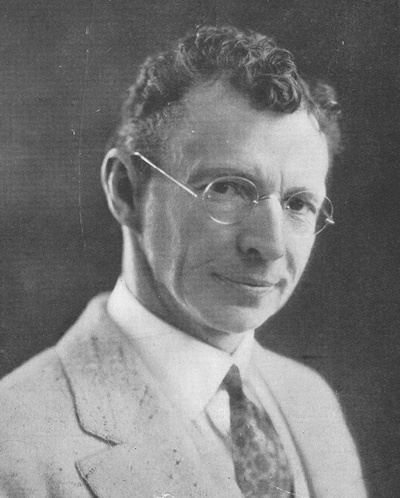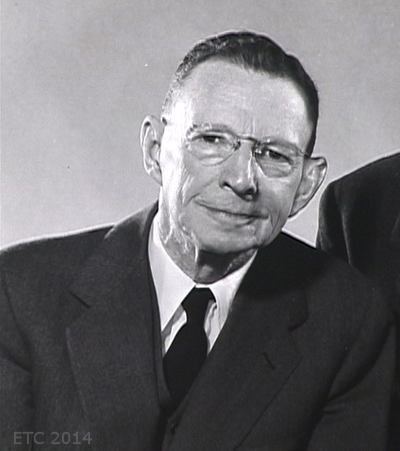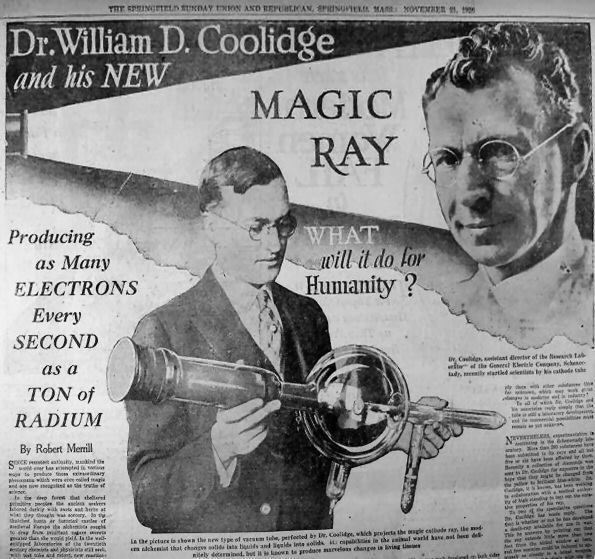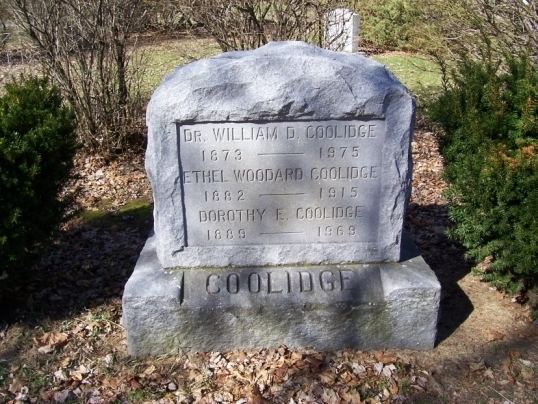Residence United States Fields Electrical engineering Role Physicist | Name William Coolidge Nationality American | |
 | ||
Alma mater University of LeipzigMassachusetts Institute of Technology Known for his contributions to the incandescent electric lighting and the X-rays art Notable awards IEEE Edison Medal (1927), Hughes Medal (1927), Faraday Medal (1939), Duddell Medal and Prize (1941) | ||
Dr william d coolidge general electric scientist and inventor of the hot cathode x ray tube
William David Coolidge (; October 23, 1873 – February 3, 1975) was an American physicist and engineer, who made major contributions to X-ray machines. He was the director of the General Electric Research Laboratory and a vice-president of the corporation. He was also famous for the development of "ductile tungsten", which is important for the incandescent light bulb.
Contents
- Dr william d coolidge general electric scientist and inventor of the hot cathode x ray tube
- 1940 X Ray Physics Documentary By William D Coolidge
- Early years
- Ductile tungsten
- Improved X ray tube
- Awards
- Later career
- Patents
- References

1940 X Ray Physics Documentary By William D Coolidge
Early years

Coolidge was born on a farm near Hudson, Massachusetts. He studied electrical engineering from 1891 until 1896 at the Massachusetts Institute of Technology (MIT). After a year as a laboratory assistant, he went to Germany for further study and received his doctorate from the University of Leipzig. From 1899 to 1905 he was a research assistant to Arthur A. Noyes of the Chemistry Department at MIT.
Ductile tungsten

Coolidge went to work as a researcher at General Electric's new research laboratory in 1905, where he conducted experiments that led to the use of tungsten as filaments in light bulbs. He developed 'ductile tungsten', which could be more easily drawn into filaments, by purifying tungsten oxide. Starting in 1911, General Electric marketed lamps using the new metal and they soon became an important source of income for GE. He applied for and received a patent (US#1,082,933) for this 'invention' in 1913. However, in 1928 a US court ruled that his 1913 patent was not valid as an invention.
Improved X-ray tube

In 1913 he invented the Coolidge tube, an X-ray tube with an improved cathode for use in X-ray machines that allowed for more intense visualization of deep-seated anatomy and tumors. The Coolidge tube, which also utilized a tungsten filament, was a major development in the then-nascent medical specialty of radiology (US patent filed in 1913 and granted as US Patent 1,203,495 in 1916). Its basic design is still in use. He also invented the first rotating anode X-ray tube.
Awards

The American Academy of Arts and Sciences awarded Coolidge the Rumford Prize in 1914. Coolidge was awarded the American Institute of Electrical Engineers Edison Medal in 1927 For his contributions to the incandescent electric lighting and the X-rays art. He rejected this prestigious award in 1926 on the basis that his ductile tungsten patent (1913) was ruled by court as invalid. He was awarded the Howard N. Potts Medal in 1926 and the Louis E. Levy Medal in 1927. Coolidge was awarded the Faraday Medal in 1939. He was awarded the Franklin Medal in 1944. In 1975 he was elected to the National Inventors Hall of Fame, shortly before his death at age 101 in Schenectady, New York.
Later career
Coolidge became director of the GE research laboratory in 1932, and a vice-president of General Electric in 1940, until his retirement in 1944. He continued to consult for GE after retirement.
Patents


